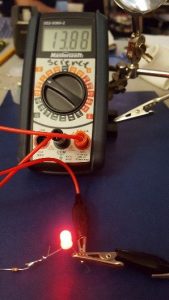 The traditional incandescent bulbs used for teaching series and parallel circuits are rated for 3 V or 6 V. The problem is that many power supplies can generate higher voltages. As a result, it is common to have many blown bulbs. With several sections teaching this unit, bulbs can quickly become in short supply. Bulb replacements can cost $1.00 each, and often are included in the general department order at the end of each semester.
The traditional incandescent bulbs used for teaching series and parallel circuits are rated for 3 V or 6 V. The problem is that many power supplies can generate higher voltages. As a result, it is common to have many blown bulbs. With several sections teaching this unit, bulbs can quickly become in short supply. Bulb replacements can cost $1.00 each, and often are included in the general department order at the end of each semester.
LED as an alternative: LED lights are rated for low voltages (3 V). However, by adding a small resistor (390 ohms) to one of the legs, the LED can be used at excessive electric potentials. After adding the resistor, the LED was successfully used at 13.88 V, the maximum value for my power supply.
Construction: The resistor and LED wire were twisted together. To be consistent, the resistor wire was attached to the anode (+) leg of the LED. To identify this, the LED was held up to a light. The smallest metal in the LED bulb is the anode (+). Solder paste was added to the two twisted wires. Using a pencil style soldering gun, the smallest drop of solder was added on to the soldering iron tip. The tip touched the paste and they were instantly soldered. Start to finish the whole process took less than a minute.
 The advantages: The LED’s now can function at higher voltages, the legs can easily fit into breadboards or can be alligator clipped into circuits, and they are cheap. A kit with 100 LEDS, and 390 ohm resistors costs less than $12.00 from Qkit Electronics, Kingston Ontario.
The advantages: The LED’s now can function at higher voltages, the legs can easily fit into breadboards or can be alligator clipped into circuits, and they are cheap. A kit with 100 LEDS, and 390 ohm resistors costs less than $12.00 from Qkit Electronics, Kingston Ontario.
This was initially presented at OAPT 2018 at Western University, London Ontario.
Dave Gervais
STAO Safety Chair
